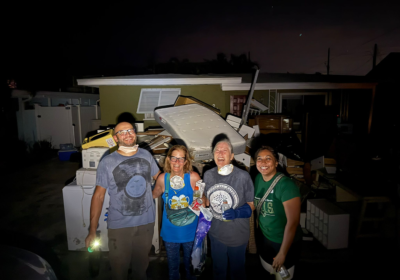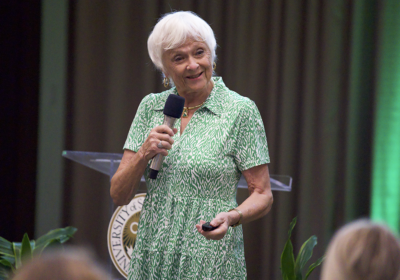Combating climate change is mandatory for sustainable future, some students say

Climate change poses a threat to the planet as greenhouse gas emissions rise and heat collects in the atmosphere. Some students desire to see change at the university level and beyond to combat the consequences of climate change in the coming years.
Florida is already beginning to experience the impacts of climate change as cities along the coast, such as those in Broward County, raise their infrastructure to stay above the rising sea level, according to a March CBS article. As a result, the changes exacerbate socioeconomic disparities by chasing the wealthy inland to higher ground and leaving disadvantaged communities gridlocked in threatened areas.
Junior environmental science and policy major Michael Kolo said he expected the impacts of climate change to be wide-reaching in Florida, affecting a variety of groups and industries.
“I expect Florida to be impacted in almost every aspect of life,” Kolo said. “Our [industries] will begin to fail as fisheries are depleted and water sources changed, our tourism will alter as the bright coral reefs of the Florida Keys will no longer be, our residential areas will become more prone to flooding and our weather events such as hurricanes will increase in strength and damage.”
As waters warm and acidify due to the concentration of carbon dioxide in the atmosphere, coral bleaching has drastically decreased oceanic biodiversity as coral populations diminish along with the creatures which inhabit them.
Several students, including sophomore accounting major Adam Silmi, pointed to alternative energy sources as a viable method of addressing climate change. They cited university projects such as the BullRunner, which employs electronic buses on certain routes, as a switch to sustainable living that could be easily integrated into student life.
Alternative energy sources, including solar, thermal and wind, avoid the release of greenhouse gasses associated with the burning of fossil fuels.
Greenhouse gasses, such as carbon dioxide, methane and nitrous oxide, augment climate change by trapping heat before it leaves the atmosphere, leading to adverse effects across the planet.
Increased atmospheric temperatures warm the ocean and land faster than their organisms can adapt to, pushing species to colder depths of water or higher latitudes to escape the heat. It also skews global climate patterns, resulting in severe drought or severe storms in some areas.
Solar would be one of the most viable forms of alternative energy for Florida due to its climate, according to Sylvia Thomas, interim vice president for research and innovation. Hydropower is another possible replacement for fossil fuels, due to abundant shorelines.
Wind power, conversely, would not be feasible in Florida, Thomas said. Due to lower levels of wind, the state would be unable to produce an adequate amount of energy.
Florida already holds the fourth place spot in the U.S. for solar energy production, following California, Texas and North Carolina. Solar energy currently supplies 4.68% of the state’s electricity, according to the Solar Energy Industries Association.
Senior electrical engineering major Sam Brown said he believes the university should incorporate more alternative energy into campus operations, even at the cost of a small fee added on to tuition.
“Of course more should always be done,” Brown said. “Until USF is 100% green energy, we have something to work toward.”
Thomas said USF demonstrates a commitment to expanding its use of alternative energy sources alongside the student body. Students would be welcomed to create a panel of USF experts on alternative energy to discuss the issue, according to Thomas.
Elizabeth Anderson, a junior environmental science and policy major, said she attempts to limit her environmental footprint by eating a more plant-based diet.
Plant-based products have grown in popularity in recent years due to their decreased environmental footprint when compared to a diet that includes animal products.
In a 2018 study that tracked 40 products that provide the majority of global nutrient intake, using five indicators across 38,700 farms and 1,600 processors in 119 countries, even the least sustainable plant-based products were found to have less of an environmental footprint than the most sustainable animal-based product.
The role of corporations in climate change’s increasing pace was another prominent concern among students, who said that major change would only happen after industry practices were modified.
Patrick Manconi, a junior computer science major, said that as a single person, he has little control over managing climate change.
“I care deeply about the environment but know my impact is ultimately too limited to matter in the greater scheme of things by living sustainably alone. The waste I produce personally is nothing compared to businesses and product producers,” Manconi said. “Whether I live sustainably or not, the environment will be the same in a few decades.”
In total, 90 companies have been shown to account for two-thirds of industrial greenhouse gas emissions. Companies such as ExxonMobil, BP and Chevron fill the atmosphere with some of the greatest quantities of carbon dioxide annually.
Many businesses are also lagging in their missions to decrease their environmental footprint, according to a study of 25 corporations that supply 5% of global greenhouse gas emissions.
Actions taken by companies such as Nestle, Amazon and Unilever were researched by the New Climate Institute, which indicated that on the current trajectory, the listed companies would decrease their emissions by an estimated 40%. In order to be considered “net-zero,” the companies would be required to reduce emissions by 100%.
“Seeing as almost all aspects of Florida life are intertwined with the environment, the better question is what will not be impacted by climate change?” Kolo said.






